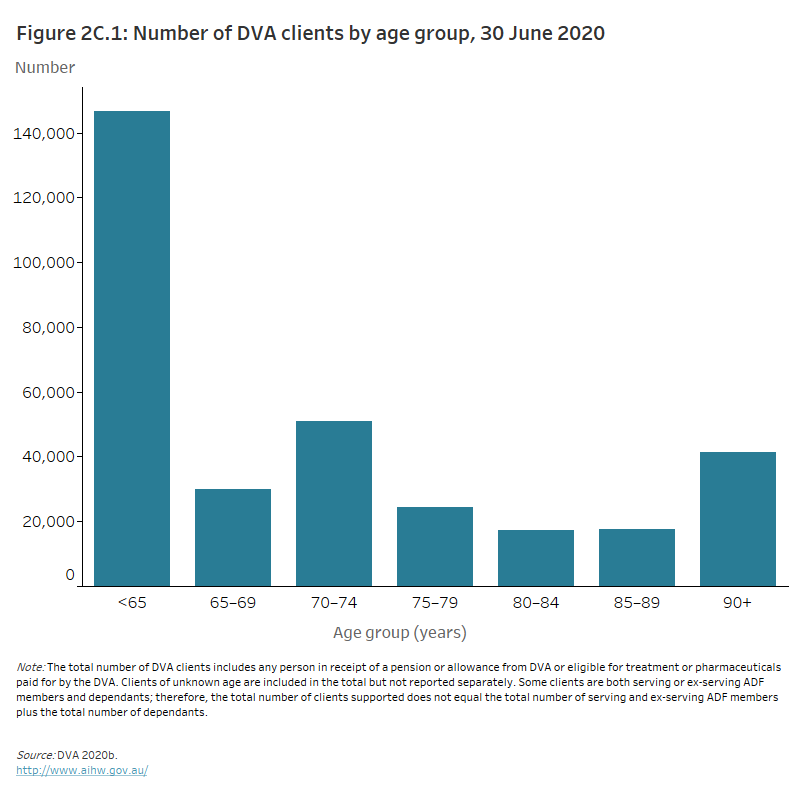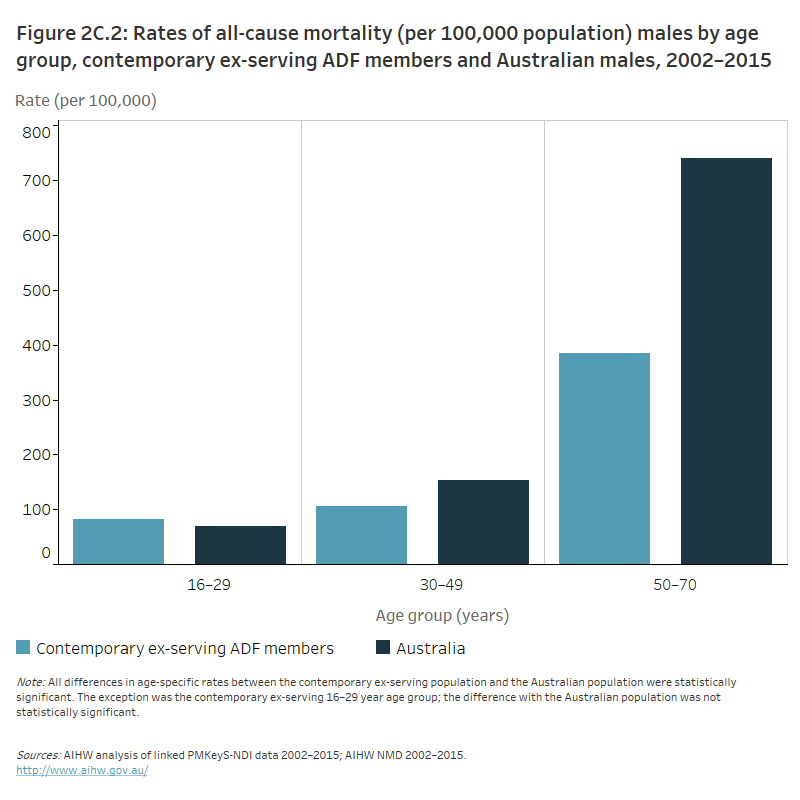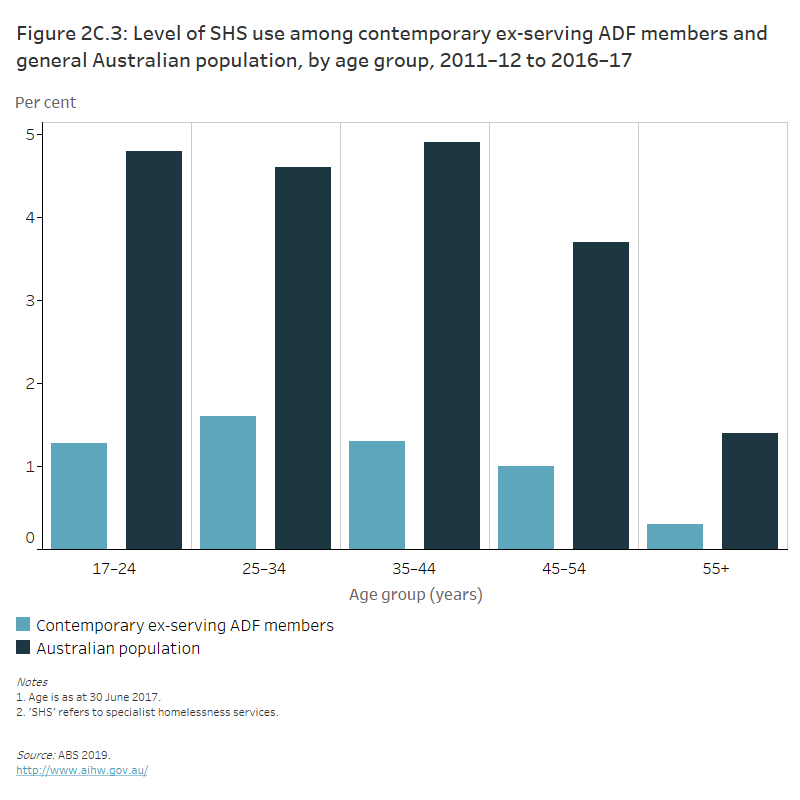Veterans
Demographic profile
People who served in the ADF, as well as the spouse, widow or widower of a serving or ex-serving ADF member, form an important minority of older Australians. This population may experience ageing differently due to factors associated with ADF service, and many experience health and welfare challenges over and above those of the Australian population.
Data considerations
- Within this article, each section references findings from a variety of data sources. This means that subpopulations of veterans and their families will often differ between sections, depending on the data source used. As such, findings across different sections of this article should not be compared.
- While the older Australian population is generally defined as 65 years and over, data on older veterans in this article are presented in differing age ranges due to differences in the data sources.
- For some sections of this article, data are only presented for males due to female population sizes being too small to report.
Who are veterans?
In 2017, the Veterans Ministers’ Roundtable responsible for veterans’ issues agreed that all jurisdictions would define a veteran as ‘a person who is serving or has served in the ADF’ (Tehan 2017). The Australian Veterans’ Recognition (Putting Veterans and their Families First) Act 2019 (Cth) defined a veteran as ‘a person who has served, or is serving, as a member of the Permanent Forces or as a member of the Reserves’.
The subpopulations of veterans covered in this article are:
- DVA clients – eligible permanent, reserve and ex-serving ADF members and their eligible family members who are supported by the DVA. These may be permanent, reserve or ex-serving members of the ADF, or the family, partner or dependant of a permanent, reserve or ex-serving ADF member. DVA clients may be identified in survey data through a question asking whether they are a card holder or payment recipient, or in administrative data where a service was funded by the DVA. In some cases, DVA clients are separated into DVA benefit or payment recipients, and DVA card holders (noting it is possible for a person to fit both categories) (AIHW 2018).
- ADF members – people who have had at least one day of permanent or reserve service in the ADF, as reported in the Defence Census and DVA annual reports. This includes both members who are still serving in a permanent regular capacity or in the reserve forces, as well as those who have separated from the ADF.
- Contemporary ex-serving ADF members – ADF members who have had at least one day of permanent or reserve service on or after 1 January 2001, and have since separated from the ADF. This subpopulation was used in previous AIHW studies on veterans, and is based on the current ADF personnel system (AIHW 2020).
- Ever served in the ADF – respondents who answered ‘yes’ when asked ‘Have you ever served in the Australian Defence Force?’ in the 2017–18 National Health Survey. This is self-reported by respondents, and may include permanent, reserve and/or ex-serving ADF members.
How many serving and ex-serving ADF members are there in Australia?
While the number of permanent and reserve ADF members is known, the exact number and characteristics of ex-serving ADF members in Australia is unknown and veterans are not readily identifiable in many general population health and welfare data sets. At 30 June 2020, the ADF comprised about 59,000 permanent (48,000 males and 11,000 females) and over 28,800 active ADF reserve members across the Royal Australian Navy, the Australian Army and the Royal Australian Air Force (Department of Defence 2019a).
According to the 2019 Department of Defence Census, around 9% of permanent ADF members were aged 50 and over, compared with 35% of ADF reserve members (Department of Defence 2019b).
At 30 June 2020, more than half of all DVA clients (55%, or over 181,500 permanent, reserve and ex-serving ADF members and their dependants) were aged 65 and over. Of DVA clients overall, around 1 in 8 (13%) were aged 90 and over (DVA 2020b) (Figure 2C.1).
Figure 2C.1: Number of DVA clients by age group, 30 June 2020
The column graph shows the number of DVA clients amongst older Australians was greatest in the 70–74 age group as well as those 90 and over. Around 147,000 DVA clients were aged 65 and over as at 30 June 2020.

Health
Health status
According to the Australian Bureau of Statistics (ABS) 2017–18 National Health Survey, almost half (47%) of males aged 55–64 who had ever served in the ADF considered themselves to be in excellent or very good health; however, this dropped to 36% among males who had ever served in the ADF aged 75 and over. This was similar for males who had never served in the ADF (52% and 36%, respectively) (ABS 2019).
Nearly 2 in 5 (39%) males aged 75 and over who had ever served in the ADF considered their health to be fair or poor, compared with 31% of males of the same age who had never served in the ADF (ABS 2019).
Chronic diseases
In 2017–18, males aged 55 and over who had ever served in the ADF generally reported similar rates of chronic diseases as the non-serving population, including arthritis, back pain and problems, and diabetes. However, males aged 65–74 who had ever served in the ADF reported mental and behavioural conditions at a rate 10 percentage points higher than males aged 65–74 who had never served in the ADF (27% and 17%, respectively) (ABS 2019).
Dispensed medication
In 2017–18, over 1 million medications were dispensed to around 70,000 contemporary ex-serving ADF members of all ages (AIHW 2019a). Consistent with the increased likelihood of developing chronic diseases with age (ABS 2018), the rate of medication dispensing per member was found to increase with age:
- Contemporary ex-serving ADF members in older age-groups were dispensed more medications than younger age groups, with almost half (47%) of all medications dispensed to members aged 50–69. For males in this age group, medications relating to the cardiovascular system were the most commonly dispensed, accounting for over one-third (39%) of all dispensing for males aged 50-69 (AIHW 2019a).
- The rate of dispensing for contemporary ex-serving ADF members increased with age, with the rate for those aged 70 and over being 35 per person. This was nearly twice as high as the rate for those aged 50–69 (19 per person) and around 10 times the rate for those aged 17–30 (4 per person). This pattern is similar in age-matched rates within the Australian population (AIHW 2019a).
Deaths
Between 2002 and 2015, rates of deaths due to any cause (all-cause mortality) for contemporary ex-serving ADF males aged 50–70 were almost half those of Australian males of the same age. In contrast, rates of all-cause mortality for contemporary ex-serving ADF males aged 16–29 were similar to those of Australian males of the same age. As expected, all-cause mortality rates increased with age (AIHW 2020) (Figure 2C.2).
Figure 2C.2: Rates of all-cause mortality (per 100,000 population) males by age group, contemporary ex-serving ADF members and Australian males, 2002–2015
The column graph shows that the all-cause mortality rate for males was greater amongst Australian males compared to contemporary ex-serving ADF members between the ages of 30–70 in 2002–2015. However contemporary ex-serving males aged 16–29 had a greater all-cause mortality rate than Australian males (81.6 and 69.0 per 100,000, respectively).

The leading causes of death for male contemporary ex-serving ADF members for 2002–2015, aged 50 and over, included coronary heart disease, lung cancer, prostate cancer, colorectal cancer and cerebrovascular disease. This is similar to the Australian population for males aged 50 and over, whose leading causes of death included coronary heart disease, lung cancer, cerebrovascular disease, chronic obstructive pulmonary disease and prostate cancer. While suicide is a leading cause of death for those contemporary ex-serving ADF members aged under 50, this is not the case among contemporary ex-serving ADF members aged 50 and over (AIHW 2020).
Aged care
The DVA provides two main services to assist older permanent, reserve and ex-serving ADF members, and war widow(er)s:
- Veterans’ Home Care (providing domestic assistance, personal care, safety-related home and garden maintenance and respite care for those with low care needs)
- community nursing services (providing clinical and personal care).
Those ADF members and war widow(er)s who are aged 65 and over needing assistance may also access mainstream aged care services, either exclusively or in addition to DVA services, as long as the services are not duplicated. These services include the Commonwealth Home Support Programme, Home Care Packages and residential aged care. While it is possible to identify DVA clients in residential aged care, at this stage it is not possible to identify how many ex-serving ADF members are accessing these mainstream community-based services.
In 2019–20, 37,700 older DVA clients (aged 65 and over) were approved for Veteran’s Home Care services and 13,800 older DVA clients received community nursing services, representing 30% and 11% of older DVA clients, respectively (SCRGSP 2021).
Serving and ex-serving ADF members eligible for Veterans’ Home Care services are those with an assessed need who hold a Veteran Gold Card, or a Veteran White Card for an accepted service-related injury or condition. Carers and family members of Gold Card and White Card holders with an accepted service-related condition may be eligible for an assessment (DVA 2019).
To receive community nursing services for an assessed clinical need, a client must have either a Gold Card or a White Card. Where a client holds a White Card, the need for community nursing services must be related to an accepted service-related injury or condition (DVA 2020a).
Housing and living arrangements
Between 1 July 2011 and 30 June 2017, 1,200 contemporary ex-serving ADF members used specialist homelessness services (SHS), representing 1.1% of contemporary ex-serving ADF members, compared with 3.4% of the Australian population. Across all age groups, the level of SHS use among contemporary ex-serving ADF members was lower than among the Australian population. For both contemporary ex-serving ADF members and the Australian population, the proportion of SHS use was lowest among those aged 55 and over (0.3% and 1.4%, respectively) (AIHW 2019b) (Figure 2C.3).
Figure 2C.3: Level of SHS use among contemporary ex-serving ADF members and general Australian population, by age group, 2011–12 to 2016–17
The column graph shows that the level of use of specialised homelessness services (SHS) was greater amongst the general Australian population compared with contemporary ex-serving ADF members, across all age groups. In the Australian population, the percentage of those using SHS was highest in those aged 35–44, at 4.9% of people in this age group. Amongst contemporary ex-serving ADF members, this percentage was highest in those aged 25–34, with 1.6% of members in this age group using SHS.

Where do I go for more information?
For more information on serving and ex-serving ADF members:
- AIHW A profile of Australia’s veterans 2018
- AIHW Health of veterans
- AIHW Medications dispensed to contemporary ex-serving Australian Defence Force members, 2017–18
- AIHW National suicide monitoring of serving and ex-serving Australian Defence Force personnel: 2020 update
- AIHW Serving and ex-serving Australian Defence Force members who have served since 1985: population characteristics 2019
- AIHW Use of homelessness services by contemporary ex-serving Australian Defence Force members 2011–17
What support is available?
Open Arms – Veterans & Families Counselling
Provides 24-hour free counselling and support to you and your family, including the Safe Zone Support – a 24-hour free anonymous counselling line.
ADF Mental Health All-hours Support Line
A confidential 24-hour telephone service for ADF members and their families.
Provides free support services if you are in crisis and need to talk to someone.
Provides 24-hour counselling services to help you cope with sexual assault or violence.
Connect with an ex-service organisation in your local area. These organisations may be able to provide you with support and resources.
ABS (Australian Bureau of Statistics) 2018. National Health Survey – first results, 2017–18: Chronic conditions. ABS cat. no. 4364.0.55.001. Canberra: ABS. Viewed 2020-21.
ABS 2019. Microdata: National Health Survey, 2017–18. ABS cat. no. 4364.0.55.001. AIHW analysis using TableBuilder. Canberra: ABS. Viewed 2020-21.
AIHW (Australian Institute of Health and Welfare) 2018. A profile of Australia's veterans 2018. Cat. no. PHE 235. Canberra: AIHW. Viewed 2021.
AIHW 2019a. Medications dispensed to contemporary ex-serving Australian Defence Force members, 2017–18. Cat. no. PHE 264. Canberra: AIHW. Viewed 2020-21.
AIHW 2019b. Use of homelessness services by contemporary ex-serving Australian Defence Force members 2011–17. Cat. no. PHE 265. Canberra: AIHW. Viewed 2020-21.
AIHW 2020. Health of veterans. Cat. no. PHE 235. Canberra: AIHW. Viewed 2021.
Australian Veterans’ Recognition (Putting Veterans and their Families First) Act 2019. No. 46 of 2019. Canberra: Commonwealth of Australia. Viewed 2021.
Department of Defence 2019a. Annual report 2019–20. Canberra: Department of Defence. Viewed 2021.
Department of Defence 2019b. Defence Census 2019 [public report (PDF 3.5 MB)]. Canberra: Department of Defence. Viewed 2021.
DVA (Department of Veterans Affairs) 2019. Veterans’ Home Care (VHC): Help so you can stay in your home. Canberra: DVA. Viewed 12 May 2020.
DVA 2020a. Community nursing services – general information. Canberra: DVA. Viewed 12 May 2020.
DVA 2020b. Department of Veterans’ Affairs annual report 2019–20. Canberra: DVA. Viewed 2020-21.
SCRGSP (Steering Committee for the Review of Government Service Provision) 2021. Report on Government Services 2021: Part F, Section 14. Canberra: Productivity Commission. Viewed 2021.
Tehan D 2017. Joint communique – Veterans’ Ministers’ meeting. Media release by Minister for Veterans’ Affairs, 8 November, Canberra. Viewed 2021.


